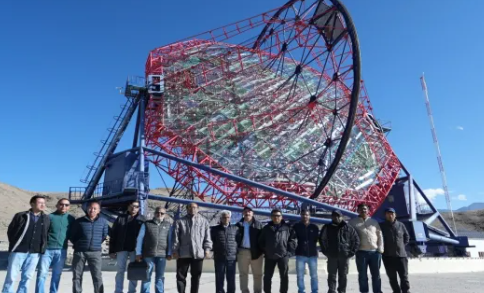Major Atmospheric Cherenkov Experiment (MACE) Telescope
The Major Atmospheric Cherenkov Experiment (MACE) telescope opened on October 4, 2024, in Hanle, Ladakh. It stands at 4.3 km above sea level, making it the highest of its kind globally. MACE features a 21-meter-wide dish, the largest in Asia. This facility was developed by leading Indian research institutions.
What are Gamma Rays?
Gamma rays are high-energy electromagnetic waves. They possess the shortest wavelength and the highest energy in the spectrum. Each gamma ray carries over 100,000 electron volts of energy. In contrast, visible light photons range from 1.63 to 3.26 eV. Humans cannot see gamma rays.
Sources of Gamma Rays
Gamma rays originate from various cosmic phenomena. These include pulsars, supernovae, and black holes. They are also produced during gamma-ray bursts. These energetic events release important amounts of gamma radiation into space.
The Earth’s Atmosphere and Gamma Rays
The Earth’s atmosphere effectively blocks gamma rays. This shielding protects living organisms from potential harm. Gamma rays can damage cells and DNA due to their high energy. To study these rays, astronomers traditionally use space-based observatories.
Detecting Gamma Rays on Earth
Ground-based techniques can also detect gamma rays. When gamma rays enter the atmosphere, they interact with air molecules. This interaction leads to the production of electron-positron pairs. These charged particles travel faster than light in air.
Cherenkov Radiation
The interaction of gamma rays produces Cherenkov radiation. This radiation emits a faint blue light. It resembles violet and blue light in the visible spectrum. The emitted light spreads over a large area, creating an ideal detection zone.
MACE as a Detection Tool
MACE is an Imaging Atmospheric Cherenkov telescope (IACT). It is designed to collect Cherenkov radiation. This data helps astronomers learn about high-energy gamma rays. MACE enhances our understanding of cosmic phenomena.
Important Facts for Exams:
- MACE: The Major Atmospheric Cherenkov Experiment (MACE) is the highest imaging Cherenkov telescope globally. It opened in Ladakh on October 4, 2024, at 4.3 km elevation.
- Cherenkov Radiation: Cherenkov radiation is emitted when charged particles exceed light speed in a medium. It produces faint blue light, aiding in the detection of high-energy gamma rays.
- Gamma Rays: Gamma rays are high-energy electromagnetic waves with wavelengths shorter than visible light. They carry over 100,000 electron volts, making them invisible to the human eye.
- Electron-Positron Pairs: When gamma rays interact with air molecules, they produce electron-positron pairs. These charged particles are crucial for detecting gamma rays via Cherenkov radiation.
Month: Current Affairs - November, 2024
Category: Science & Technology Current Affairs


